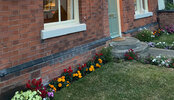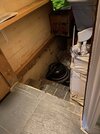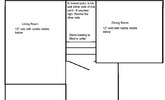I live in a detached house built sometime between 1901 and 1906. I know there was a cellar under the house as there are steps under the stairs which lead downwards, and the former owners told me that one had been filled in by the owners before them (who had owned the house for around 40 years). The reason they filled it in was to dispose of building rubble from some works.
I don't know how deep it is but I am considering excavating it for two reasons. One - the sand and cement 'capping' laid on the rubble chucked down there is excreting moisture in some places, some of which is bridging the DPC and travelling up internal walls, and two - having any form of additional space is a bonus.
I am going to head to the local archives and see if there are any plans for the house stored away there. The street it is built on was the first 'new' street in the village for several centuries at a time when there was big wealth coming in from a nearby town, so I assume there must be plans. There a few houses of a very similar style and I know the name of the firm who built the house (F. Perks & Sons), as they advertised their work on this road in the newspaper. There are also archived electoral registers which I hope will put me in touch with the former owners, if still alive (I've done a lot of genealogy for the past 15 years so I'm experienced in approaching unexpecting people...)
My question, before I start planning any excavation, is specifically about cellars in this period. Appreciate every house will vary, but I've never lived in a house with one, so I don't know what to expect. Hopefully people on here know a bit about them. Is it likely to be a cellar deep enough to stand up in, or could it be nothing more than a few feet high? I've attached some pictures to help show the house and its style
Pic 1 - Lower portion of external brickwork, three bricks deep.
Pic 2 - Attempted shot of the steps leading into the cellar (10" tall each)
Pic 3 - My crude diagram of the floor layout
I don't know how deep it is but I am considering excavating it for two reasons. One - the sand and cement 'capping' laid on the rubble chucked down there is excreting moisture in some places, some of which is bridging the DPC and travelling up internal walls, and two - having any form of additional space is a bonus.
I am going to head to the local archives and see if there are any plans for the house stored away there. The street it is built on was the first 'new' street in the village for several centuries at a time when there was big wealth coming in from a nearby town, so I assume there must be plans. There a few houses of a very similar style and I know the name of the firm who built the house (F. Perks & Sons), as they advertised their work on this road in the newspaper. There are also archived electoral registers which I hope will put me in touch with the former owners, if still alive (I've done a lot of genealogy for the past 15 years so I'm experienced in approaching unexpecting people...)
My question, before I start planning any excavation, is specifically about cellars in this period. Appreciate every house will vary, but I've never lived in a house with one, so I don't know what to expect. Hopefully people on here know a bit about them. Is it likely to be a cellar deep enough to stand up in, or could it be nothing more than a few feet high? I've attached some pictures to help show the house and its style
Pic 1 - Lower portion of external brickwork, three bricks deep.
Pic 2 - Attempted shot of the steps leading into the cellar (10" tall each)
Pic 3 - My crude diagram of the floor layout




